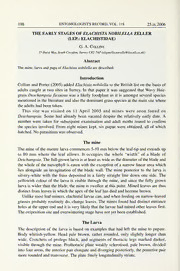
The early stages of Elachista nobilella Zeller (Lep.: Elachistidae) PDF
Preview The early stages of Elachista nobilella Zeller (Lep.: Elachistidae)
198 ENTOMOLOGIST'SRECORD,VOL. 118 25.ix.2006 THE EARLY STAGES OFELACH1STA NOBILELLA ZELLER (LER: ELACHISTIDAE) G. A. Collins 15HurstWay,SouthCroydon,SurreyCR27AP([email protected]) Abstract Themine,larvaandpupaofElachistanobilellaaredescribed. Introduction Collins and Porter (2005) addedElachista nobilella to the British list on the basis of adults caught at two sites in Surrey. In that paper it was suggested that Wavy Hair- grass Deschampsiaflexuosa was a likely foodplant as it is amongst several species mentionedintheliterature andalsothedominantgrass species atthemain site where the adultshadbeentaken. This site was visited on 11 April 2005 and mines were soon found on Deschampsia. Some had already been vacated despite the relatively early date. A number were taken for subsequent examination and adult moths reared to confirm the species involved. From eight mines kept, six pupae were obtained, all ofwhich hatched. Noparasitismwas observed. Themine mm The mine ofthe mature larvacommences 5-10 below the leaf-tip and extends up mm to 80 where the leaf allows. It occupies the whole “width” of a blade of Deschampsia. The full-grownlarvais atleastas wide asthediameteroftheblade and the whole ofthe mesophyll is eaten with the exception ofa narrow linear area which lies alongside an invagination of the blade wall. The mine posterior to the larva is silvery-white with the frass deposited in a fairly straight line down one side. The yellowish colour of the larva is visible through the mine, and since the fully grown larva is widerthan the blade, the mine is swollen at this point. Mined leaves are thus distinctfromleavesinwhichtheapexoftheleafhas diedandbecomebrown. Unlike most leaf-miners, elachistid larvae can, andwhen feeding onnarrow-leaved grasses probably routinely do, change leaves. The mines found had distinct entrance holes attheupperend anditis very likely thatthelarvaehadmined otherleaves first. Theoviposition siteandoverwintering stagehavenotyetbeenestablished. TheLarva The description of the larva is based on examples that had left the mine to pupate. Body whitish-yellow. Head pale brown, rather rounded, only slightly longer than wide. Crotchets of prolegs black, and segments of thoracic legs marked darker, visible through the mine. Prothoracic plate weakly sclerotised, pale brown, divided into fourareas, the anteriorpairelongate and diverging posteriorly, the posteriorpair morerounded andtransverse. Theplatefinely longitudinally striate. ELACHISTANOBILELLA 199 The Pupa — mm 3.0 3.2 long, uniformly pale yellowish-brown. Thorax with dorsolateral raised ridges, and three raised, roughened tubercles at the bases of the wings. Wing-cases and legs extending to apex of abdominal segment V, the former roughened but without distinct tubercles. Abdominal segments fused, except for the articulation between IV and V, and V and VI whichis present as adeep dorsal sulcus. Prominent raised dorsal and prominent lateral keels present, interrupted by the sulci between the movable segments. Cremaster of four groups of spines ventrally on IX-X, the spines rather long and abruptly expanded at their tips. Caudal projection ofX small, wider than long. The surface sculpture of the abdominal segments consists of a mixture ofwhorled wrinkles and areas ofdense punctation, the surface between the puncturesrathersmoothandshining. In captivity the larvae chose to pupate in an angle of their container, spinning a full length, transversely arranged sheet of silk above them, and attached by the cremaster and a girdle which engages with the dorsal sulcus between IV and V. This mode of pupation suggests that the larvae do not pupate on the stems of Deschampsia, but rather seek out some broader and flatter surface, perhaps on a deadleafbelowthegrass. References Collins, G. A. & Porter, J., 2005. Elachista nobilella Zeller, 1839 (Lep.: Elachistidae), a micro mothnewtoBritain.Entomologist’sRecord&JournalofVariation 117: 133-137. First record of a grasshopper, Myrmeleotettix maculatus (Thunb.) (Orth.: Acrididae),from the IsleofLewis Surprisingly, according to the national atlas (Haes, E. C. M. & Harding, P.T. 1997. Atlas ofgrasshoppers andalliedinsects in Britain andIreland), there are no records ofgrasshoppers fromthe Isle ofLewis, even thoughitis the largestofthe Hebridean islands. On 25.vii.2006 I found numbers ofMyrmeleotettixmaculatus (Thunberg) at the boundary of dunes and machair, north of the beach at Mangersta (O. S. grid reference NB 009310) and a single male to the south of the beach in dunes at NB 009308. This species is already well known from other islands in the Hebrides. My own records include: Tangasdale, Barra, dunes, viii.1981; Ruleos, Barra, dry peat moor, viii.1981; Iona, dunes, viii.1984; Loch Aineort, South Uist, peat moor, 22.vii.2006; Udal, North Uist, machair, 23.vii.2006. It is possible that the Mangersta site represents an isolatedpopulation as much ofLewis is covered by damp exposed moorland that may be unsuitable for this insect. On a previous visit to Lewis, in 1988, I failed to find grassh—oppers despite searching dune and machair areas near Uig Sands, Cliffand Kneep. John Paul, Downsflint, High Street, UpperBeeding, WestSussex BN44 3WN (E-mail: [email protected]).
